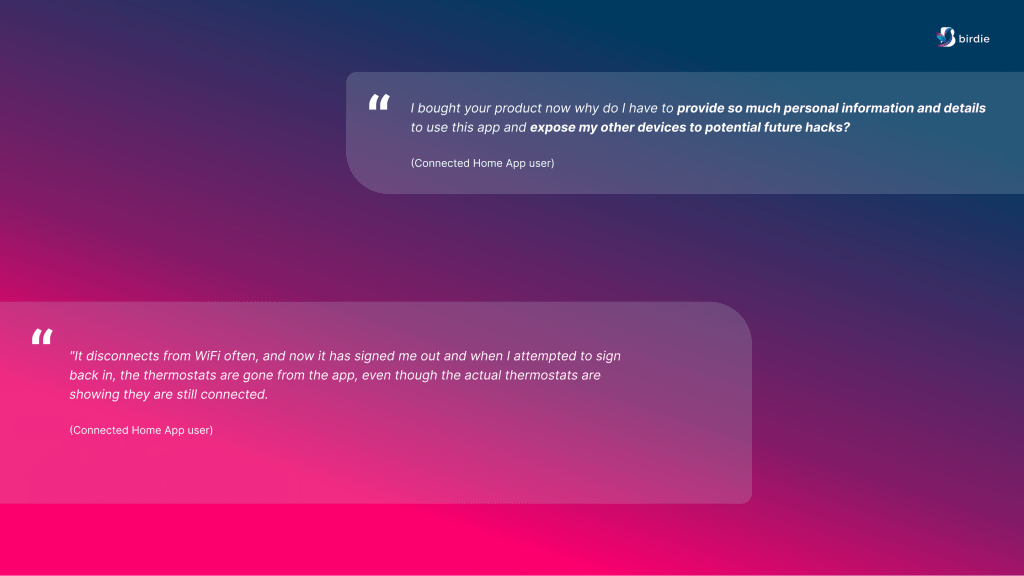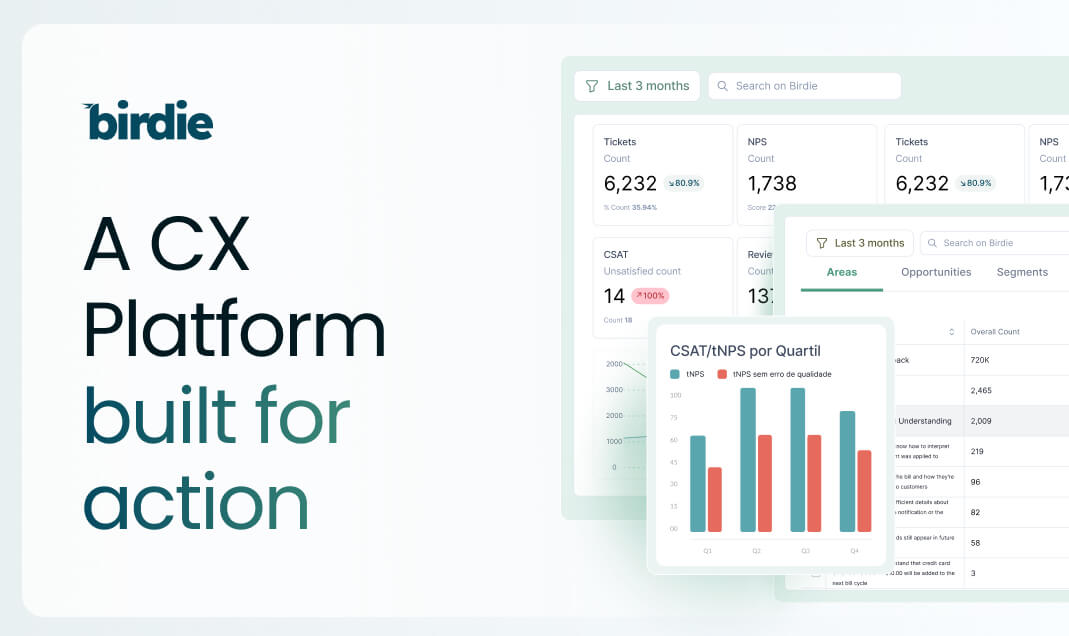
The Internet of Things (IoT) is a wonder that can make a difference in users` everyday lives, a nice example are the smart home devices. These kind of smart devices can make things more accessible and empower users in the house tasks management.
To understand the role of Connected Devices in the Smart Home, Birdie collected 1.1MM (US) Amazon` and other retailers` reviews for Air Conditioners, Refrigerators, Ranges & Ovens, Washers & Dryers, Smart Thermostats, Televisions, Dishwashers, Vacuums and Voice Interface Devices. Birdie's proprietary AI discovered the most mentioned topics in the smart home devices reviews and used NLP Sentiment Analysis to quantify each topic's share of positive and negative feedback. This positive and negative feedback ratio is the basis for the Birdie score.
Users' perspective: what are the positives and negatives of experiencing an smart home device
Being able to control devices or execute any home task remotely through an App can be very convenient. Still, such ease can show some barriers in the user experience and become a nightmare. And that starts right from the beginning of users' journey; Apps Running Requirements such as Access, Connectivity, and Stability represent 61% of users` reviews subjects. As we can see in the Running Requirements on smart home devices, a low b score (-25), the sentiment is primarily negative, pushed by operational disruptions reported.
Among all the collected smart home devices reviews, Birdie found 19% of users mentioning IoT and App-related topics, labeled as "Connected," and 81% not related to those topics, labeled as "Unconnected." In addition, Birdie discovered that consumers are 82% more satisfied with the Devices overall than Smart Home Apps. Furthermore, whenever Connected smart home devices users do not face App operational problems, they are 17% more confident with their Smart Devices than Unconnected users with their not intelligent devices.
Nowadays, Smart Home Apps are most used for Entertainment (24%) and Temperature Control (22%). Smart TV (24%) is the most popular smart device, followed by smart home devices such as Lights (18%), Thermostats (17%), Home Security devices (10%), and Speakers (8%). Laundry and kitchen smart home appliances also appear in the reviews, with less than 6% of the mentions.
Time Management with timers and alerts (16%), Notifications (16%), and Automation Tools, as routines and schedules (12%) are popular function topics among the smart home devices reviews. The bad news is that the comment sentiment is primarily negative also about function, so Smart Home Apps are not delivering an experience smart enough according to users' feedback.
Who are the smart home devices users?
Smart home owners want more than a connected device; monitoring the appliances on the phone is not enough; they want more. Beyond basic expectations met, such as running requirements and essential functions working well, users also want the App` features to enhance their everyday home tasks experience. Convenience, Time, and Energy Savings are important drivers found in the user's reviews, also Ease of Use and Voice Commands are essential attributes that users look for in a Smart Home Application.
But how can an App deliver such enhancers? That depends on who uses the App and whose life has been impacted by IoT. Birdie Insights Team found some interesting personas through the data collected.
Families
For the largest group of Smart Home users (60%), Entertainment and Relaxation are the top mentioned topics. They use Smart Home Apps to stream music and videos and playtime with the kids. Time management and House Control are also a great benefit for Moms and Dads. According to some reviews, calling everyone to dinner or waking up the kids can save time and energy. Monitoring the kids and pets in the cameras can be either peace of mind. Families also find it very convenient to set the home temperature on the way home, manage the grocery list remotely, check the security system when traveling, look at the doors and turn off the lights from bed.
Home Cookers
They represent 17% of the users, more than setting the stove from the phone, and they also can check which items are missing in the fridge to cook their favorite recipe. So when they arrive home with the ingredients bought, the stove is already at the ideal temperature, and their favorite show or music is playing, they just have to do what they really enjoy, cook.
Pet owners
Eight percent (8%) of them expect to be able to check on their pets remotely, in or out of home, through the help of security cameras and home assistant apps. Users now can control temperature, humidity, and pet feeders, with automation and scheduling functionalities even away from home, which can help save money hiring a pet sitter. Simple task reminders such as walking the dogs or feeding the fish save users time and effort and help users take care of their "buddies."
Smart home devices: bringing autonomy to people with special needs
In the Special Care (3%) context of Smart Home Assistants and Home Automation Apps users, we found empowered elders and people who need special assistance with a higher autonomy. Those tools can also help caregivers check and assist elders and children remotely. Voice control, especially, has enabled this group to control devices without having to move through a user-friendly interface (essential for these users), allowing them to get into the smart world facilities and make their lives easier. Using smart home devices, they can also have more social contact and fun with their grandchildren. Notifications help these users to manage their time: remembering everyday tasks such as taking their medicines, calling someone, or locking the entrance door, in this case, can be a lifesaver.
IoT and Home Automation can improve people's lives, but all that tech can be a little tricky, especially for some personas. Discover who and how consumers use your product/service; knowing the barriers they face is the key to developing a better design. Meet your client and fly with us!
Discover more about smart home devices in our first IoT Report
Do you want to know more about what consumers say about the IoT app experience? Recently Birdie analyzed more than 259k consumers' reviews about IoT Apps designed to manage smart devices at home or workspaces, like electronics, home appliances, printers, and document signing.

Get FREE access to the full content here, and let us know your impression of the material in the comments.








